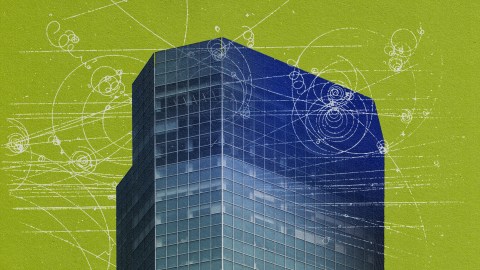The office is broken: Can conceptual “atom smashing” repair it?

- The most concerning architectural forms and shapes needing radical reinvention are office buildings.
- The rise of technology and the work-from-home revolution have substantially altered how, when, where, and even why we work.
- The office building should be a place people want to come to instead of being forced to attend.
In the mid-1990s, we developed a restaurant and bar concept that collided the cultural phenomenon of the hit TV shows Seinfeld and Friends with the societal needs and fears many Gen-Xers had in finding suitable partners, buying a home, and starting a family. In that era, there weren’t many fast-casual restaurants and options were limited to fast-food joints like Burger King or more formal-dining establishments. Asking for a “table for one,” however, at a traditional restaurant and eating by yourself at a two- or four-top table seemed humiliating. The environment did not help facilitate the ability to meet others, as asking other patrons seated at neighboring tables about their food felt like an invasion of privacy.
On top of this social discomfort, having to endure the standard structured meal courses of cocktails, appetizers, main meal, dessert, and check didn’t fit this generation’s eating habits or work/life/gym balance. To counter this, we tapped into a different cultural model and form and shape. We created a restaurant based on living room vignettes—like those we saw on Seinfeld and Friends. This innovative design approach allowed guests to pop in and out and eat whatever menu items suited their schedule while enjoying the company of a prosocial setting.
Just like being invited to a party at someone’s home, we found the living room vignettes were much better than tables for facilitating strangers to meet, talk, and get to know each other better. Much to our delight, customers concentrated on the corners of the vignette layout—say, the sofa armrest next to a chair—and were willing to share these social settings with other customers, creating a shared cocktail party vibe and environment.
In another scenario, we took a premium movie theater chain and collided it with the intimacy of the Emmy-award-winning TV series Inside the Actors Studio. The concept entailed creating an insiders’ lounge and behind-the-scenes film experience for die-hard movie lovers to hang out with other moviemakers and movie aficionados to enjoy food and drinks while hearing stories that extended the movie-going experience beyond the film.

When a national developer asked us to help them address the popular criticism that shopping centers are just about materialism that preys on younger generations, we studied what parents cared about and cataloged their concerns about childhood development. We experimented with colliding the traditional shopping center site with the standard forms and shapes of a children’s museum, a recreational park and nature trail, and a charter magnet school. That exercise gave us the courage to develop a new form and shape that focused on three primary parental concerns of childhood development: the arts, sciences, and sports. And to make the economic business model work, we developed a targeted tenant strategy to attract brands with knowledge in the arts, sciences, and sports—who also wanted to get on the good side of parents—and a new form and shape emerged.
Many standard forms and shapes, such as the mall, grocery store, and convenience store concepts are long overdue for reinvention. The same goes for the institutions of universities, museums, and performing art facilities. But the most concerning standard forms and shapes needing radical reinvention are office buildings and, by extension, downtown areas, central business districts, and urban employment centers. The rise of technology—combined with the pandemic and the work-from-home revolution—has substantially altered how, when, where, and even why we work and how companies conduct business. The number of high-rise and mid-rise office buildings sitting underutilized is alarming. According to a November 2022 article in Forbes, the world’s office buildings sit at less than 50 percent occupied.
The number of high-rise and mid-rise office buildings sitting underutilized is alarming.
We must also consider the substantial impact on local businesses that historically catered to office workers, such as coffee shops, restaurants, bars, gyms, drugstores, dry cleaners, and sundry shops. As the businesses that serve office buildings and office parks struggle to survive, the need for taxi drivers, valets, security guards, maintenance crews, window cleaners, and parking attendant jobs will continue to decrease. Following the same thread, as revenues from the local tax base lower, undesirable activities, including crime, vagrancy, loitering, and graffiti, will increase.
It’s a complicated mess with no easy answers. But instead of mandating employees commute to work like ants during rush-hour traffic to be warehoused in cubicles invented in another era, we need to accept that our fundamental patterns of behavior have changed. Our firm has been investigating ways to make the office building a place people want to come to instead of being forced to attend. In this new era of employer/employee dynamics where the best talent calls the shots, the office has to provide a bigger physical, social, and emotional payoff than the work required to go into the office. This new direction has meant smashing the typical office-building paradigm with the standard form and shape of clubs, forts, recreational centers, bars, cafés, hotels, and college campuses. We’ve also explored how to repurpose office buildings for other uses, such as university, tech hub, and laboratory space, as well as for solving the housing crisis, but these conversions are not as simple as they sound.
We need to create a national council and think tank composed of universities, researchers, urban planners, specialized real estate professionals, and design experts to smash paradigms.
The jury is still out on the future fate of underutilized office buildings, but the problem won’t fix itself. Organizations—such as the American Institute of Architects and the Urban Land Institute—are studying the downtown exodus and emigration problem in much greater detail. But it is rapidly becoming a systemic crisis in which the trickle-down effect will impact everyone, from the absence of the tax revenues collected from corporate headquarters downsizing to the funding of roads, ambulances, and public-school programs out in the suburbs.
Our political leaders must prioritize this issue as a national concern, as they have in past eras for envisioning highways, dams, airports, water supply, electrical grid, and telecommunications. We need to create a national council and think tank composed of universities, researchers, urban planners, specialized real estate professionals, and design experts to smash paradigms. We need to explore opportunities to reposition these capital-intensive properties and investments to meet the new reality of how we work today. And we must create a new vision for repurposing Central Business Districts (CBDs) because work today is becoming increasingly decentralized.




